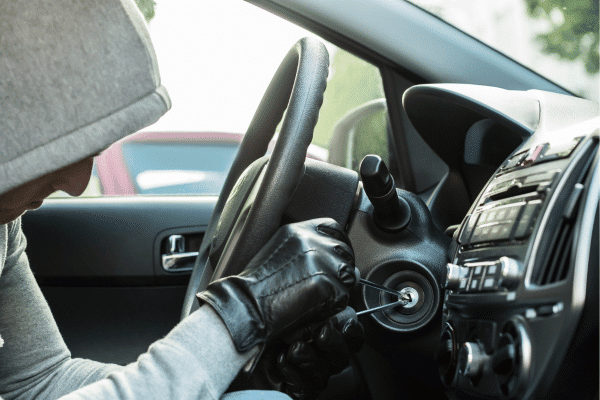You’re ready to head home after a night out, but there’s one thing missing: your car. You could have sworn you parked it right here, but it’s no longer there. Vehicle theft can happen anytime, anywhere. When it comes to keeping your car safe, where you park can make all the difference.
Theft by the Numbers
A vehicle is stolen every 32 seconds, according to the National Insurance Crime Bureau. More than a million vehicles are reported stolen each year. California and Colorado have some of the highest number of auto thefts in the country, and of course, urban centers are hotspots for theft. However, thefts happen in the suburbs too, and cars can even be taken from your driveway. In honor of July, National Vehicle Theft Protection Month, we’re taking a look at what you need to know to keep your vehicle safe.
The Worst Places to Park Your Car
Thieves are looking for a chance to steal a car. Don’t give them the opportunity to steal yours. Before you park your car for a short time, or overnight, look around and assess the area for theft potential. Is the area well lit? Are other vehicles parked nearby? Are people around? Is there a security camera or guard? Are there signs of break-ins or damage? All of these can offer clues to an area’s safety.
Avoid empty streets.
Quiet streets and alleyways offer thieves a place to work without interruption. With no one around to witness the theft, they can get in and out quickly with your vehicle.
Avoid poorly lit areas.
Thieves prefer locations where they can work without being seen. Well-lit areas increase their chances of being noticed, while poorly lit and dark locations offer cover.
Avoid high-crime areas.
Do your research before parking in a new place. If the crime rate is high, it’s worth paying for a more secure parking option. High-crime areas aren’t just seedy sections of town. They could be residential neighborhoods that are targeted by thieves.
Avoid empty lots.
You may see lots of cars at office parking lots or at schools. However, when these buildings are not in session, the empty lots provide an easy place for thieves to work. Don’t be tempted to park in an empty lot and put your vehicle at risk.
Avoid remote locations.
Places that are less frequently traveled can be attractive for thieves. Chances are these locations are less often patrolled.
Avoid parking near large vehicles.
Parking your smaller car next to a larger vehicle automatically gives thieves cover. The truck or large car blocks the view so they can work without being easily seen.
How to Protect Your Vehicle
A skilled thief can steal a car in about a minute. However, there are things you can do to make your car seem harder to steal because it will take longer, or they are more likely to get caught.
When parking away from home:
- Park in a garage with security cameras. Park in view of the cameras.
- Be aware of tow truck thieves who come in and tow away your vehicle. When you park, turn your wheel as far to one side as possible. If you have front-wheel drive, park forwards in the spot. For rear wheel drive, back into the spot. This will make it harder to tow your car.
- If you’re parking on the street, choose a busy road where there will be people and other cars the whole time your car will be there.
- Lock your vehicle. The first thing that thieves do is try the doors.
- Hide your valuables out of sight. Even loose change, phone chargers, and other items can tempt thieves to break in.
- Don’t crack your window open on a hot day. An experienced thief can use that to get inside.
- Protect your catalytic converter by etching your VIN onto it.
- Don’t run your car with the keys in it – while you’re somewhere else.
- Keep your registration and insurance in your wallet rather than your glove compartment. That will help prevent the risk of identity theft if your car is stolen.
- Use an anti-theft system. New cars come with one, and you can also add one after market.
When parking at home:
- If you can, park inside your home’s garage. Don’t leave the garage door open. Out of sight is out of mind, and thieves won’t try to steal a car they cannot see.
- Add motion sensor lights to your home and driveway area.
- Don’t leave your key fob in the car. Don’t put it near a door or window inside your home either. Thieves can use the signal to break into your vehicle. Consider keeping keys in a container that doesn’t allow digital signals to pass through.
If your car is stolen, be aware of resources for auto theft victims. Your vehicle is one of your greatest investments. Protect it with the right insurance.
This article is furnished by California Casualty, providing auto and home insurance to educators, law enforcement officers, firefighters, and nurses. Get a quote at 1.866.704.8614 or www.calcas.com.
- 15 Items That Can Overload Your Power Strip - January 16, 2026
- Music & Arts Grant Recipients – 2025 - January 13, 2026
- A Legacy of Trust: CTA and California Casualty Celebrate 75 Years Together - January 13, 2026


If possible wfhen parking on a street, try to park among the cars not at the end, to prevent a bandit tow truck from taking your vehicle
Those are great suggestions to keep in mind. I also put a Club on my steering wheel. Very old school but it’s one more deterrent.